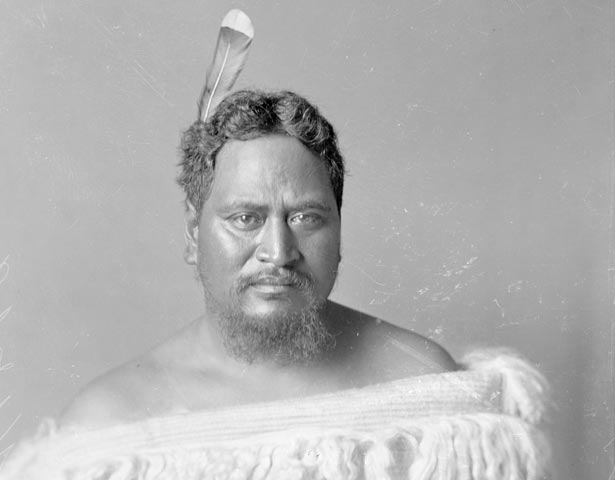
Nireaha Tāmaki, of Rangitāne and Ngāti Kahungunu, was born on the Manawatū River some time in the mid-1830s. He is perhaps best known for his bitter struggle to retain lands within the large Mangatainoka block, which the government was determined to purchase for railway construction.
The conflict reached a head in 1894. The Crown had acquired subdivisions of the large Mangatainoka block from various owners identified by the Native Land Court. Because of a survey error this land included about 5,000 acres (2000 hectares) that had not passed through the Court. Nireaha claimed a customary Māori title over this area which had not been extinguished by the Native Land Court or the subsequent government purchase. The Court of Appeal heard the case, known as Nireaha Tāmaki v Baker. Following an earlier precedent, Wī Parata v Bishop of Wellington, the Court claimed that as Māori were a 'primitive' tribal society they could not possess any customary law recognisable by the Courts. Moreover, the Crown’s land dealings with Māori were acts of state and were not subject to judicial review.
Nireaha appealed to the Privy Council in 1900. The New Zealand Court of Appeal decision was reversed. The Law Lords rejected the argument that there was no Māori customary law, and commented that it was 'rather late in the day' for New Zealand courts to adopt such a view, given that several existing New Zealand statutes, including the nineteenth-century Native Lands Acts, referred to Māori custom. The New Zealand Court of Appeal was also adjudged to have jurisdiction over the question of whether the land in dispute had been ceded to the Crown. It would be an understatement to say that the New Zealand judiciary was unhappy with this decision.
The government's response was to limit Māori rights to investigate the government’s land purchases through the courts. However, the Privy Council’s judgment was important because it acknowledged that there was a system of traditional Māori land ownership, which deserved recognition. Nireaha's involvement in this case helped him remain as a leader within Māoridom, even though it impoverished him. He died in 1911.
Adapted from the DNZB biography by Angela Ballara
Te reo version
Nō nga iwi o Rangitāne me Ngāti Kahungunu a Nireaha Tāmaki. I whānau mai ia ki ngā tahatika o te awa o Manawatū i te pokapū o te tekau atu atu i 1830. Mōhiotia whānuitia ai ia mō tana okeoke kia pupuri i te poraka whenua o Mangatainoka, i ngana rā te kāwanatanga kia hoko mai hei whakatakoto rerewē.
Ka eke te tohenga nei ki tōna taumata i te tau 1894. I hokona e te Karauna ētahi wāhanga o te poraka o Mangatainoka mai i ētahi o te hunga whai pānga i tohungia e te Kōti Whenua Māori. Nā tētahi hapa i te wā ka rūria te whenua nei, ka kuhuna tētahi whenua e 5000 eka (2000 heketea) te rahi kāore anō kia kawea mā te Kōti. Ka taunaha a Nireaha i ēnei whenua hei whenua papatipu, i te mea kāore rā anō kia kawea ki mua i te Kōti Whenua Māori, ahakoa kua hokona e te kāwanatanga. Ka rongohia te take nei e te Kōti Pīra arā, Nireaha v Baker. Ka whai te kōti i te whakataunga o te take Wī Parata v Bishop of Wellington, ka whakapae te kōti mō te Māori he iwi “mohoao”, e kore e aro ngā Kōti ki āna tikanga. I tua atu, he take kāwanatanga ngā whitiwhitinga kōrero a te Karauna me te Māori mō te whenua, e kore e taea te arotake i raro i te ture.
I te tau 1900 ka pīra a Nireaha ki te Kaunihera Motuhake a te Kuini. Ka takahurihia te whakatau a te Kōti Pīra o Aotearoa. Kāore i arongia e ngā Rōra Ture ngā kōrero e mea ana kāore he tikanga a te Māori, me tā rātou kī anō he tōmuri rawa kia pēnei te titiro a ngā kōti o Aotearoa, i te mea kei roto tonu i ētahi ture o Aotearoa, tae atu ki ngā Ture Whenua Māori o ngā 1800, ngā kōrero mō ngā tikanga Māori. I tua atu, ka kī anō rātou he wāhi tonu tō te Kōti Pīra o Aotearoa ki ngā whakawākanga mō ngā whenua ka tukua ki te Karauna. Kāore rā i rata te rāngai ture o Aotearoa ki ēnei whakatau.
Ko te urupare a te kāwanatanga, ko te tāmi i te āheinga o te Māori ki te rangahau i ngā hokonga whenua a te kāwanatanga mā roto i ngā kōti. Hāunga tērā, he mea nui tonu te whakatau a te Kaunihera Motuhake a te Kuini, i te mea i whakaae ia i reira tonu ngā tikanga a te Māori mō te whenua – he pūnaha e tika ana kia arohia. Nā te whakawākanga nei i tiketike ai a Nireaha i te ao Māori, ahakoa te pau o ana moni. Nō te tau 1911 ka mate ia.
How to cite this page
'Nireaha Tāmaki', URL: https://nzhistory.govt.nz/people/nireaha-tamaki, (Ministry for Culture and Heritage), updated 21-Mar-2023

Community contributions